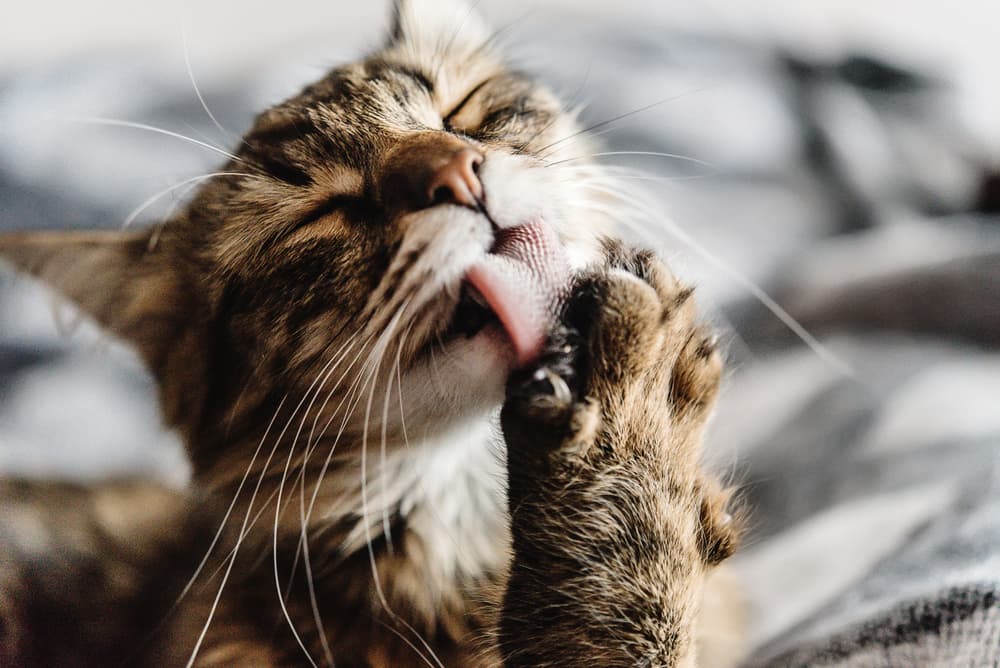All About Cat Lice

Overview
Cat lice chew on the skin of cats, causing itchiness and discomfort. The one lice species that affects cats is known as Felicola subrostratus. People cannot get lice from cats, but cats can transmit lice to other felines. Most flea products will also treat and kill lice. If your cat has lice, it's important to thoroughly clean your home.
Lice are gross little bugs that chew on our cats, making them itchy. Cats can spread this infestation of bugs to other cats in your home. Luckily, cat lice infections are rare and easy to treat.
Read more to understand why cats get lice, how to tell if your cat is infected, and what the treatment entails.
Can Cats Get Lice?
Yes, cats can get lice. Lice are small insects without wings, and measure about 1-2 mm in length. If you look up close, you can actually see them moving about on cat fur. They are usually off white to tan in color.
The one species that infests cats (and cats only) is Felicola subrostratus. Its nickname is the feline chewing louse.
Can Humans Get Lice from Cats?
Lice are species specific, meaning each type of lice is very picky about what type of animal it infests. So no, humans can’t get lice from cats, and cats can’t get lice from humans. Same story with dogs and cats—infestations can’t spread between them.
However, cats can spread lice to other cats, dogs to other dogs, and humans to other humans.
Symptoms of Lice on Cats

Lice survive by chewing on debris from a cat’s skin, which causes intense itchiness.
Symptoms may include:
- Frequent scratching or chewing of themselves
- Fur coat that is not well groomed, appears generally unkempt
- Off-white specks seen on cat fur, especially on the head and shoulders
- Scratches or irritation and redness on the skin (from excessive scratching)
- Fur loss (sometimes)
How Do Cats Get Lice?

Lice most often spreads through direct contact when cats physically touch each other. It is also possible to spread it through indirect contact. If lice eggs end up on a brush or other grooming supplies, it’s possible to spread it through contamination. This is less likely than direct contact because lice dries up and dies when not with the host. The longest length of time these insects can live without their host is seven days.
Cats usually get lice when living in dirty conditions indoors or outdoors. They must live around other cats to get the parasite. When cats live in poor conditions, they often suffer from a poor diet and lack of medical care. This can also lead to the development of other medical concerns.
Diagnosing Cat Lice
How can you tell if a cat has lice? While you may be able to see them on your cat with the naked eye, you’ll need a microscope to confirm an infestation. A veterinarian will note symptoms consistent with lice and likely see insects on your cat’s fur.
A simple test consists of using regular clear tape to stick some of the insects off of the fur onto the tape. Sometimes a veterinarian will pluck a few hairs from your cat that have insects or eggs attached. A quick look under the microscope of either sample will identify lice.
Treatment: How Do You Get Rid of Lice on Cats?

Lice is easy to treat on an individual cat. Certain flea products will kill the adult lice but not their eggs. Since eggs take two to three weeks to hatch, it’s important to apply treatment two or three times every two weeks to get rid of the infestation. Talk to your veterinarian about the best products and instructions for treating lice on your cat.
Bathing your cat is not necessary to get rid an infestation.
Home Remedies for Cat Lice
Home treatments are not very effective in controlling these parasite. Some home remedies include washing the cat with dish soap or brushing your cat with a fine toothed comb. These methods neither remove nor kill all the lice, and will likely leave behind eggs that hatch over time.
Controlling lice in a home is only possible when you treat all cats, clean your home, and wash your bedding.
If you find lice on your cat, your home likely needs cleaning before you can control the infestation. Products meant to control fleas in the home will be effective against lice. Any bedding and blankets the cat comes into contact with should be washed and dried, as the high temperatures dry out and kill the parasite. Any tools used for grooming cats, such as brushes, should be thoroughly cleaned.
Medications Used to Treat Cat Lice
Flea products that contain any one of the following will be highly effective in killing lice:
- Fipronil
- Imidacloprid
- Selamectin
Some of these products need veterinary approval and prescription, while others don’t. Regardless of what product you use, it’s important to ensure the product is labeled specifically for cats, NOT dogs. If your cat is given a dog product, it could be deadly.
General Cost to Treat Lice on Cats
Flea products cost approximately $15 per dose, so treatment of each cat will cost approximately $45. With a veterinary examination and quick microscope test, your total costs will be about $150.
Some cats may have other underlying medical conditions or, if they have matted fur, may need professional grooming that will add to the costs.
How to Prevent Cat Lice
Applying a monthly flea preventive will ward off fleas as well as lice infestations, even after direct exposure. All cats should be fed a high quality diet, and their home should be generally clean and tidy. Regular veterinary care on a yearly basis will ensure that your cat stays healthy.









